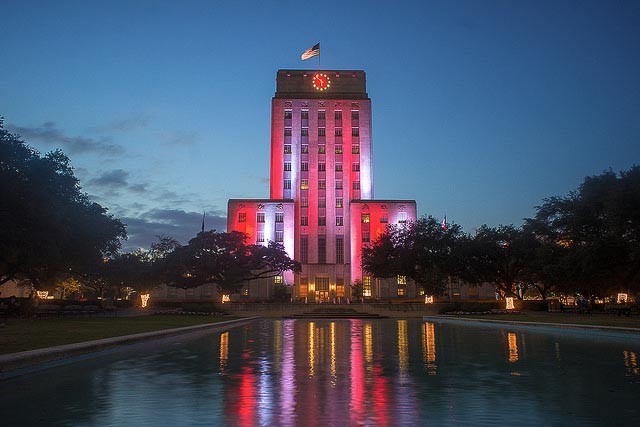 Downtown Phoenix, seen from 10,000 feet. Image via flickr/Ted Eytan.
Downtown Phoenix, seen from 10,000 feet. Image via flickr/Ted Eytan.The typical story of Sun Belt cities is that they’ve been America’s growth machines for decades as Rust Belt cities declined and coastal cities grew prohibitively expensive.
And it’s largely true. Metropolitan areas like Houston and Phoenix have steadily grown while cities like Detroit and Chicago have shrunk or flatlined. But it’s an incomplete story.
Much of the urban growth in the Sun Belt and across the country is, in fact, suburban growth. Transportation and planning expert Yonah Freemark has a new analysis that complicates the narrative around regional population growth.
The expanding populations of Houston and Phoenix, for instance, have come entirely through annexation: cities increasing their footprint, making room for people by growing out.
In the existing urban core, meanwhile, there’s been almost no growth at all. In many cases, existing urban neighborhoods have fewer people living there now than forty years ago.
“What’s surprising is that these are cities often acclaimed for their dramatic growth over the past few decades,” Freemark writes. “Yet their growth has been premised largely on annexation–suburbanization–even as their already-built up cores have declined.”
On average, he found that the 100 largest cities in 1960 have grown 48 percent since then. But at the same time, those cities saw a nearly 30 percent reduction in residents who live in the neighborhoods that were already built in 1960.
The finding makes it harder to describe cities like San Francisco as hostile to building the necessary housing to accommodate new residents, unlike Sun Belt cities like Austin and San Antonio -- at least if the goal is to foster population growth in dense, already-built areas.
Houston, for instance, has added more than 1.2 million people since 1960. But its urban core is home to nearly 120,000 fewer people now than it had back then. San Antonio, likewise, grew by nearly 800,000 people since 1960 while its urban neighborhoods lost more than 100,000 residents.
Other cities have increased their population in their urban cores t00 -- but to a much lesser degree. Phoenix has grown by 1 million people since 1960 -- third most of Sun Belt cities -- while its existing neighborhoods grew by only 9,000 people during that time.
The same dynamic is at play in Austin, Jacksonville, Charlotte, Dallas and Nashville.
But Freemark’s analysis isn’t all bad for Sun Belt urbanism. Some cities, especially Los Angeles, have managed to increase the number of people who live in their already-established urban cores since 1960. Sixty-seven percent of the 1.3 million additional people in Los Angeles since 1960 live in neighborhoods that were already built up back then.
Miami hasn’t grown as much as many of its Sun Belt peers, but like Los Angeles, much of its growth has been in urban areas. It’s grown by 120,000 people in the last 44 years, and its urban areas have grown by 100,000 people during that time. But those places buck the trend within the Sun Belt.
In some ways, those numbers illustrate the fundamental shift city leaders are saying needs to occur to continue to grow in environmentally and economically sustainable ways. San Diego, for example, grew by more than 750,000 people since 1960, and its urban neighborhoods grew by 48,000 people. Based on these numbers, San Diego is essentially a success story of infill development. And yet, just 6 percent of its growth has come through putting more people in already developed areas, rather than just expanding its footprint into undeveloped area.
With the exceptions of Los Angeles and Miami, Sun Belt cities are a long way from accommodating a substantial portion of their population growth through the urbanist ideals their leaders often espouse.

